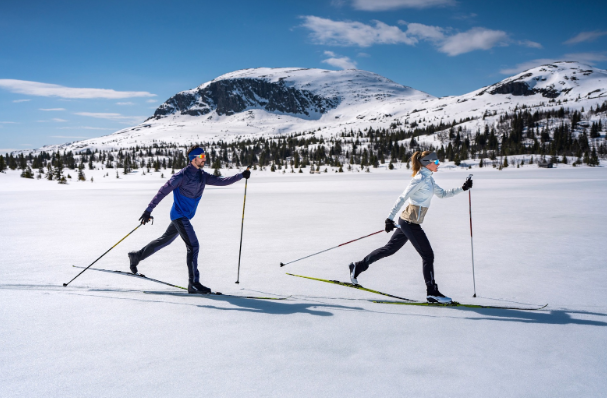
Cross country skiing is one of the most exciting and healthy winter sports. Unlike downhill skiing, cross country skiing does not require tall mountains or ski lifts. Instead, you move across snowy fields, forests, and trails using your own strength. Cross country skiing is loved because it combines adventure, fitness, and the beauty of nature.
Cross country skiing is also known as Nordic skiing. People of all ages enjoy it because it is easy to start and can be done in many snowy places. It is a low-cost activity compared to downhill skiing, and it gives your body a full workout. If you are looking for a fun way to enjoy winter and stay fit, cross country skiing might be the perfect choice for you.
Table of Contents
What is Cross Country Skiing
Cross country skiing is a winter sport where skiers use skis and poles to move over snow-covered land. Unlike downhill skiing, the goal is not to slide down steep slopes but to travel across flat or rolling terrain. It started many years ago in Scandinavia as a way for people to travel in snowy areas. Over time, it became a popular recreational sport and a part of the Winter Olympics.
Today, there are two main types of cross country skiing:
- Classic skiing – where skiers move their skis forward in straight tracks.
- Skate skiing – where skiers push off in a side-to-side skating motion.
Both types give amazing exercise and let you enjoy snowy landscapes.
The Benefits of Cross Country Skiing
Cross country skiing is more than just fun—it is also great for your health. Here are some of its main benefits:
- Full Body Workout
Unlike many sports, cross country skiing uses almost every muscle group. Your arms, legs, back, and core all work together. - Cardio and Endurance
It is one of the best cardio exercises. Regular skiing helps improve stamina and keeps your heart strong. - Low Impact Sport
Since it is done on snow, it puts less stress on your joints compared to running or other hard-surface sports. - Mental Health
Being outside in nature, breathing fresh air, and enjoying snowy landscapes can reduce stress and improve mood. - Affordable and Accessible
You don’t need expensive ski lifts or resorts. Many parks and trails are open for free or at a low cost.
Essential Equipment for Cross Country Skiing
If you want to try cross country skiing, you will need some basic gear. The right equipment makes your skiing experience safer and more enjoyable.
- Skis: Lighter and narrower than downhill skis. Choose classic or skate skis based on your style.
- Poles: Longer than alpine ski poles, helping you push forward efficiently.
- Boots and Bindings: Special boots that clip into bindings on the skis. They are flexible and comfortable for long distances.
- Clothing: Layered clothing is best. Wear a moisture-wicking base layer, an insulating middle layer, and a windproof outer layer.
- Safety Gear: Sunglasses, gloves, and sometimes a helmet depending on conditions.
Learning Cross Country Skiing as a Beginner
Many beginners worry that cross country skiing is difficult. The truth is, with a little practice, anyone can learn. Here are steps to get started:
- Start with Classic Skiing – It is easier than skate skiing and is the best option for beginners.
- Find a Flat Trail – Look for groomed tracks in parks or ski centers.
- Practice Balance – Stand on skis and get comfortable moving without falling.
- Learn the Glide – Push off with one ski and glide with the other, using poles for balance.
- Take Lessons – If possible, join a beginner class or watch online tutorials.
Best Places for Cross Country Skiing
Cross country skiing can be done anywhere with snow, but some locations are famous for their trails.
- Norway & Sweden – Birthplace of the sport with hundreds of kilometers of trails.
- Canada – Banff and Quebec are popular destinations.
- United States – Colorado, Vermont, and Minnesota have great ski centers.
- Europe – Switzerland, Finland, and Austria are world favorites.
Even if you don’t live near these areas, many local parks and forests create trails during winter.
Safety Tips for Cross Country Skiing
Safety should always come first when skiing. Here are tips to stay safe:
- Warm up before you ski to prevent injuries.
- Carry water and snacks since skiing burns lots of energy.
- Dress in layers to avoid getting too hot or cold.
- Know your trail and stay on marked paths.
- Ski with a buddy, especially in remote areas.
Training and Fitness for Skiing
Cross country skiing is demanding, so staying fit helps improve performance. Off-season training includes:
- Running, cycling, or swimming for cardio.
- Strength training for arms and legs.
- Balance exercises like yoga or Pilates.
This will make skiing easier and more enjoyable when the snow comes.
Why People Love Cross Country Skiing
People enjoy cross country skiing for many reasons. Some love it as a peaceful way to explore nature. Others use it for competition and fitness. Families enjoy it together because it’s safe and fun for all ages. Skiing clubs and communities often gather for races, events, and social activities, making it a sport that connects people.
Cross Country Skiing in the Olympics
Cross country skiing has been part of the Winter Olympics since 1924. Athletes compete in different distances and styles, from sprints to long endurance races. Watching Olympic cross country skiing is inspiring, showing how much skill and strength the sport requires.
Environmental Benefits of Cross Country Skiing
Unlike motorized winter sports, cross country skiing is eco-friendly. It does not require fuel or machines, and it helps people connect with nature without harming the environment. Skiing encourages outdoor activity and supports local winter tourism in a sustainable way.
Conclusion
Cross country skiing is more than just a winter sport—it is a lifestyle. It combines exercise, fun, and the beauty of snowy landscapes. Whether you are a beginner trying classic skiing for the first time or an expert mastering skate skiing, this sport has something for everyone. With simple equipment, safe practices, and a love for adventure, cross country skiing can make your winter unforgettable.
FAQs
Q1: Is cross country skiing hard to learn?
No. Classic cross country skiing is beginner-friendly and can be learned in just a few hours of practice.
Q2: Do I need expensive equipment?
Not at all. Many ski centers rent skis, poles, and boots for affordable prices.
Q3: How many calories does cross country skiing burn?
It burns between 500–700 calories per hour, making it one of the best calorie-burning winter activities.
Q4: Can children and older adults enjoy cross country skiing?
Yes. It is safe for people of all ages, as long as they stay on easy trails.
Q5: What is the difference between classic and skate skiing?
Classic skiing uses straight tracks, while skate skiing uses a skating motion. Classic is easier for beginners.




